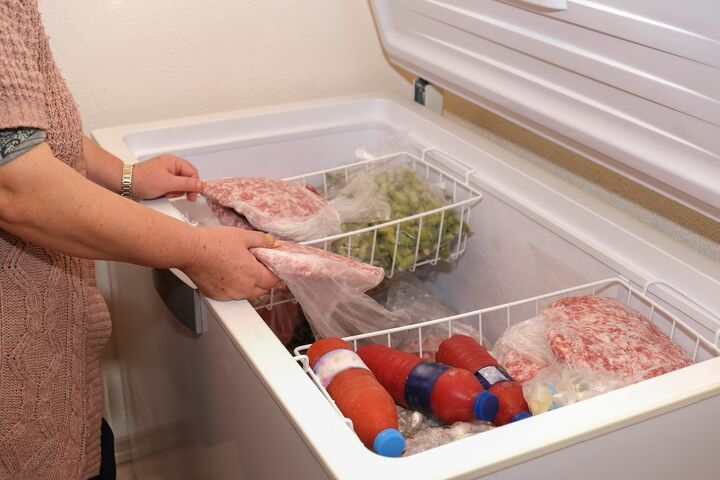How Long Can A Deep Freezer Go Without Power

When a major storm is heading your way there are all sorts of preparations you need to make. There are flashlights and candles to gather. Then there is your water and food supply to think about as well. In this scramble to find yourself ready for unpredictable severe weather you are also bound to think of the food you have on hand. It is always a good idea to have ample non-perishable food items, but what about your perishable food in your freezer?
Food in a deep freezer lasts an average of 48 hours without power. Factors like freezer size, what is inside it, and how often the freezer is opened affect how long it can keep food cold. If the freezer is mostly empty, it may only keep food safe upwards of 24 hours. If, however, you have a full upright deep freezer, it may keep food cold and safe for up to four days.
Knowing how long your freezer can go without power is critical to your well-being. This will help you know how long perishable food can last in the event of a weather disaster. It also will determine whether or not the food in question is safe to consume after the power comes back on. Food poisoning is not something you want to gamble with. So understanding the variables involved when it comes to keeping a freezer cold without power is essential to keeping you safe.
How Long Will A Freezer Keep Cold After Power Outage?
Most health and safety experts agree that a freezer can keep food at a safe temperature for up to 48 hours. The “safe” temperature is generally regarded as below 40 degrees Fahrenheit. This means that a freezer will keep foods frozen, then thaw, and likely hit a danger zone of 40 degrees and higher after 48 hours.
This doesn’t mean a freezer will keep everything inside it frozen for all 48 hours, only that the food will be safe to consume for that long. This 48-hour window, however, can increase or decrease significantly depending on several factors.
5 Factors Affecting Time Freezers Can Go Without Power
1. How Often You Open The Freezer
Perhaps the most important, and controllable, variable is how often the freezer is opened when the power is out. When there is no power, there is also no way to replenish cold air when it escapes from an open freezer door. This means each time the freezer door is open, the freezer temperature increases in temperature, causing frozen items to melt quicker.
It is best to keep the freezer closed the entire time the power is out. After 48 hours, you can check the freezer thermometer and see if it is still at a safe temperature. At this time it is usually a good idea to transfer perishables to a freezer with ample ice, and start cooking what you can.
2. How Full Is The Freezer
The amount of food and other freezable items also impacts how long it can safely go without power. For example, a nearly empty freezer has little to keep it cold. This means as soon as the limited items have thawed, the temperature will more quickly increase.
A completely filled freezer filled with items like ice and dense meats, on the other hand, can keep a freezer cold much longer. This is why it is advisable to fill your freezer with water bottles and ice packs before a storm, so you have a freezer filled with ice, keeping it colder longer.
3. What Is the Freezer Full Of
The items you keep in your fridge can also determine how long it will stay cold. Items like rolls and other baked goods tend to heat up fairly quickly. Water and meat-based items, on the other hand, take much longer to heat up.
This is because items like ice have a high specific heat, meaning it takes a lot of energy to raise their temperature. This is the other reason many reach for water bottles and ice blocks before a storm, as frozen water greatly increases how long a freezer stays cold.
4. Quality Of Insulation vs. Outside Temperature
Other factors to consider include the quality (and age) of your freezer, and the outdoor temperature. If you have a brand new freezer with air-tight seals, your freezer is likely to remain cold for its optimum length, regardless of outdoor temperatures.
If, however, your freezer seals are at all vulnerable or less than perfect, heat can slowly find its way in. This is where outdoor temperature can come into play. A storm in the middle of the winter, for example, will likely result in your freezer staying colder for longer than if you have a tropical hurricane.
5. Size Of Freezer
Just as a full freezer can stay cold longer than an empty freezer, the size of a fridge can also impact how long a freezer stays cold. A large deep freezer filled to the brim can last up to 4 days, for example. A small freezer attached to a refrigerator may last only 24 hours. This is because a large freezer has more frozen product, meaning it will take more time to heat up all that surface area. After all, ice cubes melt faster than icebergs.
Make Sure You Have A Working Freezer Thermometer
With all these variables, it is difficult to pinpoint the exact amount of time your specific deep freezer can go without power. This is why having an accurate refrigerator and freezer thermometer is so important.
Before a storm, make sure you test the thermometer and ensure its accuracy. Keep the thermometer in the freezer, and only open the freezer when you need to (in order to preserve the temperature). Be sure, however, to check the temperature every time you open the freezer, and log to time and temperature each time.
How To Determine If Your Frozen Food Is Safe To Consume
When the power returns, it is crucial you immediately inspect the freezer. There are several signs that will help you determine whether or not the contents, and which contents, are safe to consume.
Check The Thermometer
Once the power returns, you should immediately check the thermometer in the freezer. After all, you can expect the thermometer to drop rapidly once power returns. If you forget to do this for a few minutes, you can choose your biggest piece of meat in the freezer, and use a meat thermometer to check its temperature. When it is well below 40 degrees, or still frozen, you should feel confident. If it is close to 40 degrees, it is likely not safe to consume. As the saying goes: “When in doubt, throw it out.”
Is Food Still Frozen?
If the food and bottles of water you stored in your freezer are still frozen the odds are that all the perishable food items in the freezer are also still safe. If, on the other hand, you notice that everything has thawed, you should take certain precautions.
The more sensitive food items should be removed from the freezer. This includes meats, poultry and dairy products. Other products, like baked goods and frozen vegetables should be safe. This is, however, as long as the temperature did not linger at or above 40 degrees Fahrenheit.
Ice Crystals Or Pools Of Water
Ice buildup can be a real pain, and it is wise to regularly defrost your deep freezer. This frost, however, can turn out to be quite handy when determining whether or not your freezer kept your food safe.
If you notice that there are still those pesky ice crystals lining the edge of your freezer, or even a thin sheet of ice, then this is a sign that your freezer stayed below freezing for the most part.
If, however, you notice a pool of water at the bottom of your fridge, or a fresh sheet of ice (that was likely a pool of water before the freezer turned back on), then this is a warning sign.
This does not necessarily mean your deep freezer was in the danger zone of 40 degrees or above. It does, however, mean it was above 32 degrees for long enough to melt ample ice.
Some Food Should Not Be Re-Frozen
Remember that just because your freezer keeps food below 40 degrees does not mean all the food can be re-frozen. Meat, seafood and poultry, for example, should not be re-frozen once it has thawed. Certain bacteria can develop if food is frozen, thawed, and refrozen. It can put the food at risk and cause food poisoning.
This food should be cooked immediately if you are certain to stay at a safe, yet unfrozen, temperature. If you cannot be certain, toss it.
Concluding How Long A Freezer Can Go Without Power
When your power goes out, an imaginary clock secretly turns on. This clock is a timer that starts counting down how long your freezer can last without power. On average, a freezer can last 48 hours without power and still keep food at a safe temperature.
There are, however, several variables that affect how long a freezer can keep food safe without power. Some of these variables include how full the freezer is, how large the freezer is and how often it is opened. Make sure you have a freezer thermometer to ensure you never consume foods stored at unsafe temperatures.

Tom Gaffey is an expert writer who currently resides in Washington D.C. Tom has a passion for real estate and home improvement writing, as well as travel and lifestyle writing. He lived the last twelve years in Hawaii where he worked closely with luxury resorts and event planners, mastering his knowledge of aesthetics and luxury products. This is where he found his passion for home improvement and a keen interest in DIY projects. Currently, Tom resides in Washington D.C, and also working on his debut fiction novel.
More by Tom Gaffey



























